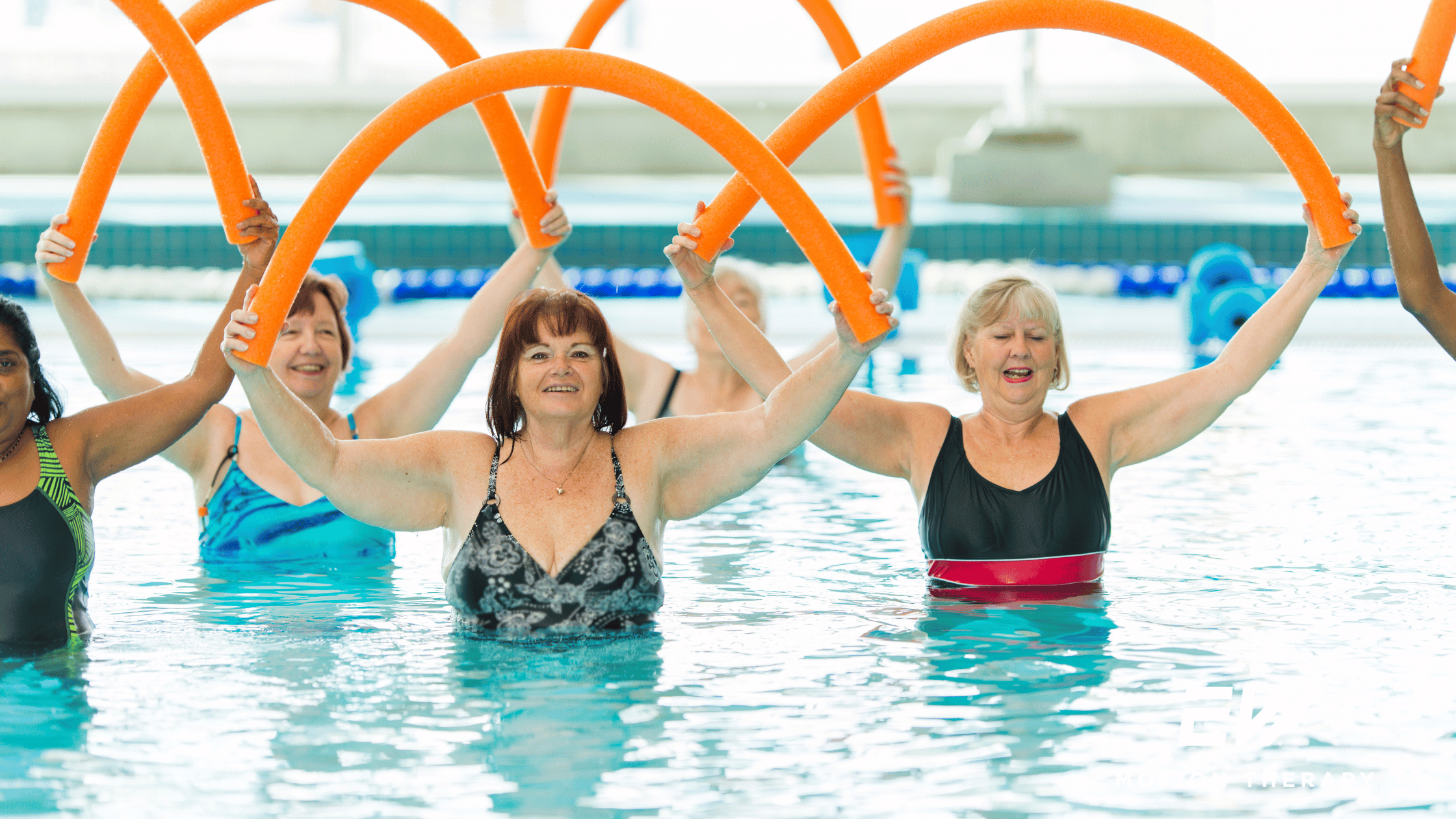The Benefits of Aquatic Therapy and Swimming for Older Adults

Licensed Physical Therapist, PT, DPT // EW Motion Therapy Homewood
As we age, maintaining physical health and mobility becomes increasingly important. One effective and enjoyable way for older adults to stay active is through aquatic therapy and swimming. These activities offer a range of benefits, from improving cardiovascular health to reducing joint pain. We recommend swimming when applicable for our clients at EW Motion Therapy, especially for those who need to build strength without stressing joints. You may decide that our physical therapy doesn’t fit your needs. However, you can still read this article as we explore the advantages of aquatic therapy and swimming for older adults, compare specific options for aquatic therapy, discuss safety considerations, and explain how aquatic therapy can be integrated with physical therapy.
Benefits of aquatic therapy and swimming
Improved cardiovascular health
Swimming is an excellent full-body cardiovascular exercise that can help improve heart health. The buoyancy of water reduces the impact on weight-bearing joints, making it ideal for older adults with arthritis or other joint issues. Regular swimming can also decrease the risk of coronary artery disease, type 2 diabetes, and high blood pressure.
Enhanced mobility and flexibility
Aquatic therapy provides a low-impact environment that can help improve mobility and flexibility. The water resistance helps strengthen muscles and increase energy output without putting excessive strain on the joints. This can be particularly beneficial for older adults with limited mobility due to arthritis or other conditions.
Pain relief
The warm water in many aquatic therapy pools can help soothe sore muscles and joints. The water’s buoyancy also reduces the pressure on painful joints, providing relief and allowing for more comfortable movement. This can be especially beneficial for individuals with chronic pain conditions such as fibromyalgia.
Increased muscle strength
Water resistance helps build muscle strength without the need for heavy weights. This is particularly important for older adults, as maintaining muscle mass can help prevent falls and improve overall functional ability. Aquatic exercises can target specific muscle groups, especially the extremities, allowing for a tailored approach to strength training.
Specific options for aquatic therapy
Warm water therapy pools
Warm water therapy pools are specifically designed for therapeutic exercises. The water temperature stays between 90 and 94 degrees Fahrenheit, which helps to relax muscles and improve circulation. These pools often have features such as underwater treadmills, resistance jets, and handrails to assist with exercises. Warm water is ideal for many conditions, but you should check with your healthcare physician or physical therapist to see if this is a good choice for you.
Hydrotherapy pools
Hydrotherapy pools are another option for aquatic therapy. These pools are often larger and have features such as underwater massage jets, adjustable water depth, and resistance equipment. Hydrotherapy can help various conditions, including post-surgical rehabilitation, injury recovery, and chronic pain management. Combining warm water and massage jets can relieve pain and improve mobility.
Water aerobics classes
Water aerobics classes are popular for older adults looking to improve their fitness in a fun, social setting. These classes are typically held in standard swimming pools and involve a variety of exercises designed to improve cardiovascular health, strength, and range of motion. Water aerobics can be a great way to stay active, meet new people, and enjoy water exercise and socialization benefits.
Open lane swimming
Open-lane swimming offers a flexible and independent approach to aquatic exercise. This option allows individuals to swim laps at their own pace, providing an excellent cardiovascular workout. Open-lane swimming can help improve endurance, muscle strength, and overall fitness. It also offers a sense of freedom and relaxation, making it an excellent choice for those who enjoy swimming at their own rhythm. You can even add a kickboard or fins to enhance the workout.
Bad Ragaz ring method
The Bad Ragaz ring method is a specialized form of aquatic therapy that uses flotation rings to support the body while performing resistance exercises in the water. This method is particularly beneficial for improving muscle strength, coordination, and flexibility. It involves guided movements from a physical therapist and exercises tailored to the individual's needs, making it an excellent option for those with specific rehabilitation goals or chronic conditions. The support provided by the flotation rings allows for precise control and execution of movements, enhancing the effectiveness of the therapy.
Safety considerations for older adults in the pool
While aquatic therapy and swimming offer numerous benefits, it is essential to consider safety to prevent injuries and ensure a positive experience.
Supervision and instruction
Older adults should always have supervision when participating in aquatic activities. This could be a qualified instructor, lifeguard, physical therapist, or a second set of eyes. Proper instruction is crucial to ensure that exercises are performed correctly and safely. It is also vital to listen to your body - if you feel weak, tired, or lightheaded at any time, you should exit the water.
Pool accessibility
Ensuring that the pool area is accessible is essential for older adults. This includes handrails, ramps, and lifts to enter and exit the pool. Non-slip surfaces around the pool area can also help prevent falls.
Health screenings
Older adults should have a health screening before beginning any new exercise program to identify any potential risks. This can help tailor the aquatic therapy program to the individual's specific needs and ensure that it is safe and effective. Anyone experiencing contagious diseases, influenza, incontinence, a urinary tract infection, or open wounds should not enter the water.
Pool depth
Pool depth is a critical safety consideration in aquatic therapy due to its significant impact on resistance, buoyancy, stability, thermal properties, and versatility. Water resistance is essential for strengthening muscles and improving cardiovascular health without the risk of injury, with deeper water providing greater resistance for more intense workouts and shallower water reducing joint impact for gentle rehabilitation. Additionally, buoyancy in deeper water supports individuals with weight-bearing difficulties, aiding those with lower limb injuries or excess weight. However, too much buoyancy can affect balance, especially for non-swimmers. Pool depth also influences the thermal properties of water, with deeper pools retaining heat better for muscle relaxation and pain reduction, while shallower areas can be cooler to reduce inflammation.
Integrating aquatic therapy with physical therapy
Aquatic therapy can be an excellent complement to traditional physical therapy. Many physical therapists incorporate aquatic exercises into their treatment plans to take advantage of the unique benefits of water exercise.
Rehabilitation
Aquatic therapy is particularly useful for rehabilitation after surgery or injury. Some exercises may be easier in the water than on land immediately following a procedure. The buoyancy of the water allows for gentle movement and improving endurance without placing undue stress on weight-bearing joints, which can help speed up recovery and improve outcomes.
Chronic conditions
For individuals with chronic conditions such as arthritis, fibromyalgia, or back pain, aquatic therapy can provide significant relief and improve quality of life. The warm water and low-impact environment make it easier to perform exercises that might be too painful on land.
Functional improvement
Physical therapists can use aquatic therapy to help older adults improve their functional abilities. This includes exercises to improve balance, coordination, and strength, essential for maintaining independence and preventing falls.
Aquatic therapy and swimming offer many benefits for older adults, from improving cardiovascular health and muscle strength to providing pain relief and enhancing mobility. With various options available, there is something to suit everyone's needs and preferences while considering safety. Integrating aquatic therapy with physical therapy can further enhance the benefits, making it a valuable addition to any older adult's health and wellness routine.
By incorporating aquatic therapy and swimming into their regular activities, older adults can enjoy improved health, increased mobility, and a better quality of life. Whether for rehabilitation, chronic pain management, or general fitness, the healing properties of water offer a unique and effective way to stay active and healthy as we age. At EW Motion Therapy, we always recommend aquatic therapy as a valuable addition to anyone’s health and wellness routine, as it integrates seamlessly with our physical therapy. To learn more about what your physical therapy might cost, download our free pricing guide below.


